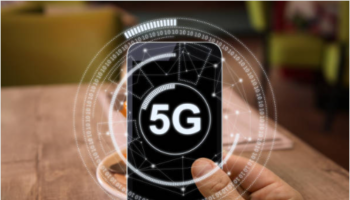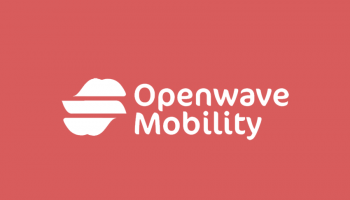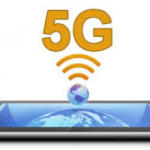 Summary: As telcos across globe are rolling out widespread 4G -LTE Network, the global telecom fraternity is already upbeat about ‘5G’ or ‘Fifth Generation’ of technologies. As ‘5G’ has started getting more attention, despite 4G-LTE has yet to reach tipping point globally, we decided to dig down deeper to understand, why ‘5G’ would be important and what is it made up of? The blog looks at some of these aspects in detail with additional resources for interested readers to check further.
Summary: As telcos across globe are rolling out widespread 4G -LTE Network, the global telecom fraternity is already upbeat about ‘5G’ or ‘Fifth Generation’ of technologies. As ‘5G’ has started getting more attention, despite 4G-LTE has yet to reach tipping point globally, we decided to dig down deeper to understand, why ‘5G’ would be important and what is it made up of? The blog looks at some of these aspects in detail with additional resources for interested readers to check further.
Imagine…Fast forward 2025…You are getting ready for office. There is an important presentation at office to CXOs. Your 5G Phablet rings…You are asked to send presentation copy ASAP, even before you reach office. While you are getting ready at home, you quickly upload slides to ‘Dropbox’ and share link to your boss. While driving to office, you put car on ‘Auto’ mode, and discuss fine points with your boss on uninterrupted video-call. By the time you reach office, you are almost done through your presentation, even before you deliver it to CXOs.
That’s what the promise of ‘5G’. Although to some extent, we can do couple of things in above scenario even today; the services are far cry from expected. We still can’t do uninterrupted video streaming on-the-go and forget about uploading huge files without help of ‘High Speed Wi-Fi’ at home. The fictitious 5G Phablet, in the above story, can provide seamless connectivity experience to end user, without any manual intervention, irrespective of the type of network available. Going beyond tech jargon, the kind of productivity promised by 5G is simply phenomenal.
So what’s 5G all about?
In terms of cellular generations 5G is the latest, and still at very nascent stage of development. In fact, according to Ericsson, standardization work for 5G would start around 2016, while first commercial networks are likely to be seen after 2020 only. What’s so surprising that, still few OEMs (Original Equipment Manufacturers) are not sure of upgrade path of moving from 4G to 5G, and avoiding the term ‘5G’ altogether in literary jargon. So questions pops up- are these 5G talks too early to discuss? 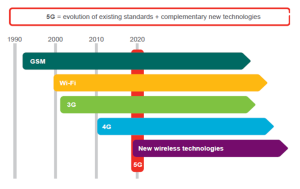
There could be two possible reasons for all 5G attention. One- OEMs and tech vendors are creating hysteria surrounding next generations of technologies f0r creation of new demands or leading the chart on innovation and influencing the standardization bodies like 3GPP for pushing early on the tasks. Second, which is also my favorite, is the real need of evolved cellular standard, originating from exponential growth of mobile devices and data consumption, where perfect blend or seamless integration of various disparate radio standards is required to create ‘Super Information Highway’. Does that mean, existing technologies, including LTE and LTE-A aren’t sufficient in meeting these demands? Not necessary!
Moving from 1G (Analog) to 4G (LTE), the cellular technology evolved to great extent. In fact, from 2G, which was also the first digital cellular technology, the evolution of generation is more on certain parameters like improving network throughput (DL and UL both), support for new mobile broadband services, meeting high network capacity demands (Data) and reduction in network latency (< 10 ms). With 5G, the 3GPP, the governing body behind cellular standardization, is yet to define its objective on these parameters and define 5G fully.
So what’s 5G? In nutshell, 5G is newest and evolved cellular technology. It’s supposed to be far more bandwidth (spectrum) efficient, faster and supporting high network capacity. By year 2020, the number of devices connecting to global networks would be at least 100 times (100 x) more than present number. 5G would help in connecting billions of devices, going beyond human interactions and paving new ways for M2M (Machine to Machine) connectivity. It’s supposed to create a real ‘Networked Society’ or rather help in creation of ‘Networked Society’.
As operators are gearing to launch 4G or even upgrade the present 3G network to 3.5G or 4G, talking about 5G seems little scary. 3GPP has yet to define 5G and its objectives. But then, before every generation of cellular network is launched, the actual definition and standardization work starts at least decade earlier. Take case of 3G- first 3G commercial networks was launched in year 2000, but actual standardization work started around mid1990. Even for 4G or HSPA networks, formal standard definitions were released starting from year 2005. So it’s safe to assume that 5G would take actual shape only beyond year 2020 (or around period 2020-25).
What’s new in 5G? According to some industry sources, there won’t be any new ‘Radio Technology’ innovation required for defining 5G, but existing radio technologies, deployed in UMTS-HSPA, LTE, LTE-A and 802.11n/.11ac can be re-used for ‘5G Radio Access’ as well. It would be certain combination of present radio technologies, which are already operating at Shannon’s Noise Free Channel Capacity Limit. Moreover, 5G would go beyond and have different used cases, especially in M2M, D2D (Device to Device) and Inter-Vehicular communication. 5G should also cater to very high density deployments and enable multi-hop communication with ultra-reliability.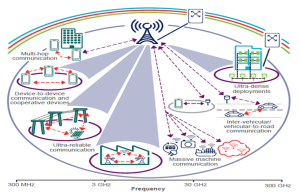
What spectrum band is suitable for ‘5G’? There is no unanimity among task groups yet. Although frequency band of sub-6 GHz is considered suitable for ‘5G’, there are also certain groups pushing for spectrum beyond 10 GHz to launch ‘5G’ services, just because these bands offer high capacity and less crowded. Presently in case of 4G, there are at least 40 different spectrum bands defined globally in TD and FD LTE categories. Every country has allocated different bands for 4G based on available spectrum. This has led to challenges on handsets designs, as in some cases, device antennas should cater to 4G band as low as 700 MHz and as high as 2.6 GHz. Not all 4G bands (TD and FD) are supported by single handset till date. Apple iPhone is probably the best among support of highest number of 4G bands globally. Other device vendors have either started following Apple or started releasing country specific 4G band supporting devices. 5G services would look into this aspect more elaborately and help is more uniform global spectrum definition in future for less stringent handset antenna designs.
From telecom operator’s perspective, 5G should deliver better ‘QoS’ at lowest TCO per bit of network, by seamlessly integrating disparate radio access technologies. Moreover, the deployment of SON, SDN and NFV solutions should bring down the OPEX costs and create new revenue opportunities from networks for telcos. Big Data analytics should help telcos in delivering personalized services and creating customized offers, not possible by present generations of technologies. Small Cells would bring better coverage to end users, relieving macros from high capacity needs, by enabling high density network deployments. For end users, 5G means fatter bandwidth pipes of end-to-end connectivity, delivering information faster, with highest possible QoS resulting into best possible user experience. It would be interesting to see how upgradation path is defined from 4G to 5G.
IEEE ComSoc has recently released very interesting infographic on ‘Road to 5G’. The same is shared below for interested readers. ‘The Mobile Network Team’ has also launched new blog for tracking all global developments on 5G front, which has some excellent resources on ‘5G’. GSA Team has already created separate repository of ‘White Papers on 5G’, which can also be checked for more details. Ericsson blog, the leader in 5G technology reviews, has also some interesting info on next generation technologies.
It would be quite early to speculate on 5G, but as said, cellular evolution and process of standardization always starts decade prior to actual commercial network deployments. 5G would not only enable faster speeds and reduced network latency, but creation of truly ‘Networked Society’ by connecting billions of devices and creation of more efficient networks.


